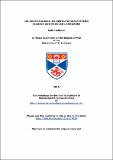Files in this item
On dots in boxes, or Permutation pattern classes and regular languages
Item metadata
| dc.contributor.advisor | Linton, Steve | |
| dc.contributor.author | Hoffmann, Ruth | |
| dc.coverage.spatial | 95 | en_US |
| dc.date.accessioned | 2015-07-27T13:26:25Z | |
| dc.date.available | 2015-07-27T13:26:25Z | |
| dc.date.issued | 2015 | |
| dc.identifier.uri | https://hdl.handle.net/10023/7034 | |
| dc.description.abstract | This thesis investigates permutation pattern classes in a language theoretic context. Specifically we explored the regularity of sets of permutations under the rank encoding. We found that the subsets of plus- and minus-(in)decomposable permutations of a regular pattern class under the rank encoding are also regular languages under that encoding. Further we investigated the sets of permutations, which in their block-decomposition have the same simple permutation, and again we found that these sets of permutations are regular languages under the rank encoding. This natural progression from plus- and minus-decomposable to simple decomposable permutations led us further to the set of simple permutations under the rank encoding, which we have also shown to be regular under the rank encoding. This regular language enables us to find the set of simple permutations of any class, independent of whether the class is regular under the rank encoding. Furthermore the regularity of the languages of some types of classes is discussed. Under the rank encoding we show that in general the skew-sum of classes, separable classes and wreath classes are not regular languages; but that the direct-sum of classes, and with some restrictions on the cardinality of the input classes the skew-sum and wreath sum of classes in fact are regular under this encoding. Other encodings such as the insertion encoding and the geometric grid encoding are discussed and in the case of the geometric grid encoding alternative and constructive ways of retrieving the basis of a geometric grid class are suggested. The aforementioned results of the rank encoding have been implemented, amongst other previously shown results, and tested. The program is available and accessible to everyone. We show that the implementation for finding the block-decomposition of a permutation has cubic time complexity with respect to the length of the permutation. The code for constructing the automaton that accepts the language of all plus-indecomposable permutations of a regular class under the rank encoding has quadratic time complexity with respect to the alphabet of the language. The procedure to find the automaton that accepts the language of minus-decomposable permutations has complexity O(k⁵) and we show that the implementation of the automaton to find the language of simple permutations under the rank encoding has time complexity O(k⁵ 2ᵏ), where k is the size of the alphabet. Further we show benchmark testing on previous important results involving the rank encoding on classes and their bases. | en_US |
| dc.language.iso | en | en_US |
| dc.publisher | University of St Andrews | |
| dc.subject.lcc | QA76.9M35H7 | |
| dc.subject.lcsh | Computer science--Mathematics | en_US |
| dc.subject.lcsh | Formal languages | en_US |
| dc.subject.lcsh | Permutations | en_US |
| dc.title | On dots in boxes, or Permutation pattern classes and regular languages | en_US |
| dc.type | Thesis | en_US |
| dc.type.qualificationlevel | Doctoral | en_US |
| dc.type.qualificationname | PhD Doctor of Philosophy | en_US |
| dc.publisher.institution | The University of St Andrews | en_US |
This item appears in the following Collection(s)
Items in the St Andrews Research Repository are protected by copyright, with all rights reserved, unless otherwise indicated.

